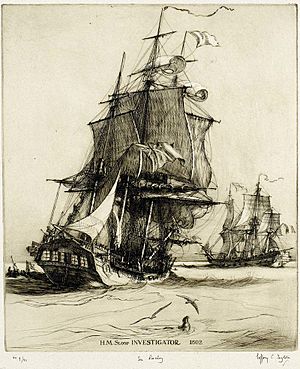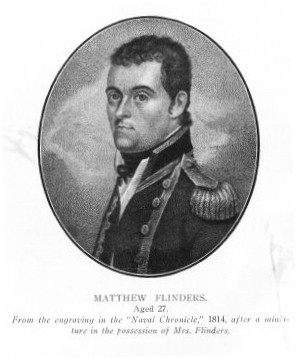HMS Investigator (1801) facts for kids

20th-century drawing of HMS Investigator.
|
|
Quick facts for kids History |
|
|---|---|
| Name | Fram |
| Builder | Unknown, at Monkwearmouth, Sunderland |
| Launched | 1795 |
| Fate | Sold 1798 |
| Notes | Collier |
| Name | HMS Xenophon |
| Acquired | 1798 |
| Renamed | HMS Investigator (1801) |
| Fate | Sold 1810 |
| Name | Xenophon |
| Acquired | 1810 by purchase |
| Fate | Broken up about 1872 |
| General characteristics | |
| Tons burthen |
|
| Length |
|
| Beam |
|
| Draught | 15 ft (4.6 m) |
| Depth of hold |
|
| Propulsion | Sails |
| Sail plan | Sloop |
| Complement | 80 |
| Armament |
|

HMS Investigator was a famous ship that explored the coast of Australia. She started as a merchant ship called Fram in 1795. The Royal Navy bought her in 1798 and renamed her HMS Xenophon.
In 1801, she became a survey ship named HMS Investigator. Under the command of Matthew Flinders, she was the first ship to sail all the way around Australia in 1802. The Navy sold her in 1810, and she went back to being a merchant ship named Xenophon. She was likely taken apart around 1872.
Contents
The Ship's Early Life
The ship Fram was built in Sunderland, England. She was a collier, meaning she carried coal. She worked along the northeast coast of England.
In 1798, the Royal Navy bought her and refitted her. They added 22 cannons to her. She was then renamed HMS Xenophon and used as an escort ship. Her job was to protect other ships.
Commander George Sayer took charge of Xenophon. In 1799, he brought some Irish rebels, including James Napper Tandy, as prisoners from Hamburg to England.
Exploring Australia
Preparing for a Big Journey
A famous scientist named Sir Joseph Banks wanted to map the Australian coastline. He also wanted to study the plants and animals there. The Admiralty (the Navy's leaders) chose Xenophon for this important trip.
She was a good choice because she didn't sit deep in the water. This meant she could sail closer to shore. She also had lots of space for supplies. However, she was not in the best condition.
The Navy changed Xenophon into a discovery ship. This happened between November 1800 and March 1801. They added new cabins for scientists and space for plant samples. Her cannons were reduced to make more storage room. She was then renamed Investigator.
On January 19, 1801, Lieutenant Flinders was chosen to command Investigator. He arrived on January 25. Flinders later wrote that Investigator was a good ship for discovery voyages. She was like the ships recommended by Captain Cook.
Sailing Around Australia
Investigator left England for Australia on July 18, 1801. She stopped at the Cape of Good Hope. Then she sailed across the Indian Ocean. On December 6, 1801, she saw Cape Leeuwin in Southwest Australia.
The expedition stayed at King George Sound (Albany) for a month. Then they began to map the Great Australian Bight. This part of the coast was 2300 kilometers long.
A Sad Accident
On February 21, 1802, a sad accident happened. A small boat with eight crew members, including the ship's master John Thistle, capsized. They were trying to return to the ship in rough water at dusk. No one survived. Flinders named the nearby land Cape Catastrophe. He called the area where they anchored Memory Cove.
Meeting the French
Investigator continued exploring the coast. Flinders mapped Port Lincoln and Kangaroo Island. On April 8, at Encounter Bay, they met a French ship called Géographe. It was led by Nicolas Baudin. The two captains were friendly. They didn't know that their countries had just signed a peace treaty. Both thought their countries were still at war.
Continuing the Voyage
After sailing through Bass Strait, Investigator visited King Island and Port Phillip. She arrived at Port Jackson (Sydney) on May 9, 1802. The ship stayed there for ten weeks for repairs. Twelve new men joined the crew. One was an Aboriginal man named Bungaree. Flinders had sailed with him before.
On July 22, Investigator left Port Jackson. She sailed north with another ship, Lady Nelson. But the Lady Nelson had problems and had to return to Port Jackson.
Investigator sailed close to the east coast. She passed through the Great Barrier Reef and Torres Strait. While mapping the Gulf of Carpentaria, the crew checked the ship's wood. They found it was rotting and leaking badly. The ship's carpenter said it wouldn't last more than six months.
Flinders sailed to a Dutch settlement in Timor to find a new ship. But he couldn't find one. Many crew members were sick with diseases like dysentery and scurvy. So, Flinders had to cut the survey short. He sailed back to Port Jackson quickly for repairs. This meant he couldn't map the north and west coasts as he wished.
Flinders did complete the trip around Australia. He had to throw two heavy anchors overboard to make the ship lighter. These anchors were found by divers in 1973. They are now on display in museums. One is at the South Australian Maritime Museum. The other is at the National Museum of Australia.
Investigator reached Port Jackson on June 9, 1803. Governor Philip Gidley King ordered a survey of the ship. The survey found that the ship was not worth repairing. They said it was impossible to make her seaworthy again.
Flinders left the Investigator in Port Jackson. She was used as a storage ship. He tried to return to England as a passenger on another ship, HMS Porpoise (1799) (HMS Porpoise).
Later Years (1804–1810)
In 1804, Governor King ordered another survey. This one found that Investigator could be repaired. Workers cut down the front deck and changed her rigging. She became a brig (a type of sailing ship). In 1804, Lieutenant John Houston commanded her for local duties.
While in Sydney, Investigator helped raise Lady Barlow. This ship had sunk during a storm.
On May 23, 1805, Commander William Kent sailed Investigator back to England. Two of Flinders' botanists, Robert Brown and Ferdinand Bauer, were on board. They carried their collections of plants. The ship faced several strong storms but arrived safely in Liverpool.
In November 1805, Captain Kent was told to move Investigator to Plymouth. This short trip was very hard. A disease, typhoid fever, spread on board. Many crew members, including officers, became sick. Six crew members also ran away in Liverpool. There was no doctor or medicine on the ship. Captain Kent also noticed that the food in the ship's hold was old and bad.
Investigator sailed anyway. She faced heavy storms near Cornwall. A strong wind near The Lizard broke most of her sails and rigging. Part of the main mast was also damaged. Kent decided to stop the voyage to Portsmouth. He brought Investigator into Falmouth for repairs. Two crew members died from the disease.
On November 13, Kent wrote that Investigator was "a more deplorable crazy vessel... perhaps not to be seen" in the Navy. The damaged and sick-ridden Investigator arrived in Plymouth on November 21. She was declared unfit for sea. On December 22, her crew were moved to other ships. In January 1806, the ship was taken out of active service. Two years later, she was used as a prison hulk.
In 1810, it was decided to sell her for breaking up. But she was sold in December to a merchant, George Baily, for £1,253.
Commercial Service (1810–1872)
After being sold, Investigator was rebuilt as a merchant ship. She was now called Xenophon again. She continued to sail all over the world.
Her last voyage was in 1853. She arrived at the Australian port of Geelong on July 30. She carried timber and other goods. Xenophon then sailed to Melbourne. There, she was sold and turned into a storage hulk. A hulk is an old ship used for storage.
She was registered in Melbourne in 1861. Her ownership changed again in 1868. The ship's record was closed in 1872. The note said she was "broken up," meaning she was taken apart.
Images for kids
-
Matthew Flinders, commander of HMS Investigator.



